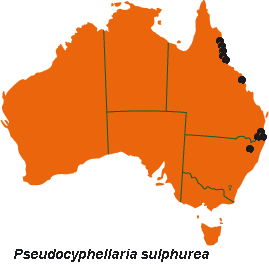



Australian Biological Resources Study
| Checklist of the Lichens of Australia and its Island Territories | ||
| Introduction | A–D | E–O | P–R | S–Z | Oceanic Islands | References | ||
| Pseudocyphellaria sulphurea (Schaer.) D.J.Galloway | ||
| Lichenologist 17: 306 (1985); Sticta sulphurea Schaer., in A.Moritzi, Syst. Verz. 127 (1846). T: Java, [Indonesia], s. loc., H.Zollinger 1860x; lecto: L 910, 182-20, fide D.J.Galloway, Lichenologist 17: 306 (1985). ***** Sticta demutabilis Kremp., J. Mus. Godeffroy 1(4): 98 (1874). T: Savai'i, [Western] Samoa, E.Gräffe 106; holo: M; iso: W. ***** Sticta karstenii Müll.Arg., Flora 64: 505 (1881); Pseudocyphellaria karstenii (Müll.Arg.) Szatala, Ann. Hist.-Nat. Mus. Nat. Hung. 7: 40 (1956), nom. inval. T: Bellenden Ker Range, Qld, Karsten 2; holo: G 002020. | ||
| Thallus irregularly spreading, often in large, tangled clones, loosely attached centrally, 5–15 (–25) cm wide. Lobes very variable, linear-elongate, ±dichotomously branching, (1–) 2–8 (–12) cm long, (1–) 3–8 (–12) mm wide, contiguous or discrete; apices free, divergent, rounded, pointed or furcate, complex-imbricate centrally; lobe margins entire, markedly thickened above and below, with occasional white pseudocyphellae. Upper surface pale grey-green, olivaceous to fawnish or red-brown when dry, lettuce-green when wet, glossy, conspicuously dimpled, punctate-impressed; without isidia, maculae, phyllidia, pseudocyphellae or soredia. Medulla white. Photobiont green. Lower surface pale whitish to pale yellowish or buff, noticeably wrinkled-ridged, thinly tomentose from margins to centre or ±glabrous. Pseudocyphellae scattered, fleck-like, minute at margins, to 0.5 mm diam., white. Apothecia marginal, sessile, 0.5–2.5 mm diam.; disc pale to dark red-brown, matt, epruinose; exciple pale yellow-brown, coarsely areolate-scabrid. Ascospores fusiform-ellipsoidal, 1-septate, (22–) 25–28 (–30.5) × 6.5–8 (–11) µm, yellow-brown to red-brown. CHEMISTRY: 7β-acetoxyhopane-22-ol (major), hopane-7β,22-diol (trace), hopane-15α,22-diol (major), tenuiorin (trace), methyl gyrophorate (trace), gyrophoric acid (trace) and 4-O-methylgyrophoric acid (major). |  |
|
| Occurs in eastern Qld and north-eastern N.S.W., on trees, shrubs, rotting logs and branches, and rock outcrops in montane rainforest. Common throughout the Pacific. | ||
| Galloway et al. (2001) | ||
| Checklist Index |
| Introduction | A–D | E–O | P–R | S–Z | Oceanic Islands | References |
This work is copyright. Apart from any use as permitted under the Copyright Act 1968, no part may be reproduced by any process without prior written permission from Australian Biological Resources Study. Requests and inquiries concerning reproduction and rights should be addressed in the first instance to Dr P. McCarthy. These pages may not be displayed on, or downloaded to, any other server without the express permission of ABRS.